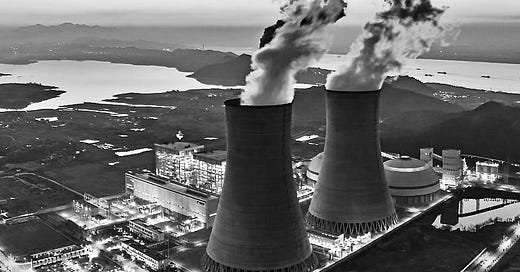America Had the Blueprint. China Built the Thorium Future
How thorium is redefining energy and leaving the West behind
“Now I am become Life, the sustainer of worlds.” For the team of American physicists and engineers who developed a clean, safe, virtually limitless nuclear fuel cycle, it stands as the perfect riposte to Oppenheimer’s invocation of the Bhagavad Gītā — “Now I am become Death, the destroyer of worlds” — as he watched the first atomic bomb detonate in 1945.
The story of one of science’s greatest gifts to humanity begins in 1828, when Swedish chemist Jakob Berzelius — a titan of the European Enlightenment and codifier of the chemical symbols still in use today — isolated a heavy, silvery metal from a black Norwegian rock.
In it, he had uncovered what the alchemists of antiquity might have called the prima materia — the elemental key to transformation. He named it thorium, after Thor, Norse god of thunder, never imagining that this abundant ore might one day answer humanity’s insatiable hunger for energy.
Over a century later, Alvin Weinberg — American-born son of Russian Jewish immigrants and a nuclear physicist driven by tikkun olam, the moral imperative to repair the world — recognised thorium as the alchemical magnum opus of a safer, cleaner, and vastly more abundant nuclear future.
A contemporary — and outspoken critic — of Oppenheimer, Weinberg condemned conventional nuclear power as a ‘Faustian bargain.’ Guided by his own moral compass, he pursued an alternative path.
By 1959, at the height of America’s industrial and scientific might, Weinberg led a secretive, elite research team probing new physics in search of Etz Chayim — the Tree of Life — a source of boundless, life-giving energy.
Unlike uranium or plutonium, thorium is not fissile but fertile — incapable of sustaining a chain reaction alone, it transforms under neutron bombardment into a fissile fuel, unlocking vast energy potential.
Six years later, their experimental molten-salt reactor achieved criticality, inaugurating a radically new, inherently safe nuclear fuel cycle — one capable of powering the planet for millennia. The thorium fuel cycle was proven viable. The technology was real. The implications for humanity’s future were epochal.
Alongside the Moon landing a decade later, this triumph ranks among humanity’s greatest — both born from America’s boundless ambition and shaped by Enlightenment ideals: rational enquiry, science, and optimism.
Yet the Cold War mind could not bear a weaponless wonder. The Pentagon pulled the plug on the project — shutting it down despite Weinberg’s conviction that it was America’s greatest technical achievement.
Why? Not because it failed. Yes, the Molten Salt Experimental Reactor was taken offline 225 times (only 58 planned) as engineers battled corrosive salts, novel materials, and untested systems. But these were mere engineering hurdles — no justification for burying a civilisation‑changing technology in darkness, for reasons of war. They held Prometheus’s fire in their hands — and used it to forge chains.
The reason was simple — thorium couldn’t be weaponised. It produced no plutonium. It offered no strategic advantage in the Cold War’s nuclear calculus. In an era defined by the arms race, the Pentagon wasn’t in the business of generating civilian electricity — it wanted more nuclear bombs, always more.
Even today, nuclear power has little to do with lighting homes. Like the space programme, it’s a military endeavour in civilian drag — the electricity merely a by‑product of building nuclear weapons.
Thorium’s virtues — clean, safe, abundant — became fatal flaws in a system designed not for prosperity but for mutually assured destruction, where any technology that did not feed the war machine was deemed expendable.
Then, in 2010, came the ultimate act of strategic folly — the US quietly declassified the thorium reactor files. Bureaucratic incompetence? Institutional stupor? Whatever the cause, it was a breathtaking giveaway of a new energy singularity.
A treasure trove of reactor blueprints, test data, and design notes lay waiting for anyone who knew where to look — a gift‑wrapped energy revolution, left on the curb. Washington, long captive to its military‑industrial complex, had already written thorium off — a divine inheritance abandoned.
Beijing didn’t look a gift horse in the mouth. Within a year of the US declassification, it made mastering the thorium fuel cycle a national priority — recognising its revolutionary potential. Thorium reactors held out the promise of a virtually limitless supply of cheap, safe, and sovereign energy, boasting 200x the efficiency of uranium and a 98% clean burn rate. Their promise wasn’t just China’s energy independence but a path for every nation — removing a primary driver of conflict.
In the spirit of the Chinese ideal “上善若水” — “the highest good is like water, benefiting all without contention” — Beijing frames thorium as a source of shared progress. Yet make no mistake: water’s persistence carves through stone. This is harmony with purpose — a quietly formidable strategy shaping the liminal space between a putrescent old world order and the agonising birth of a new one.
Which is why Beijing swiftly mobilised a team of 700 top engineers, led by their visionary scientist Xu Hongjie, to unlock thorium’s potential. Rather than simply reverse-engineering US designs, they refined and optimised the technology.
After 13 years of continuous, round-the-clock development in Wuwei, Gansu province, they designed, built and fully validated a 2 MW molten salt reactor running on thorium fuel.
Their pioneering design overcame formidable engineering challenges, enabling uninterrupted refuelling and eliminating the costly shutdown cycles that plague conventional pressurised water reactors (PWRs). By using molten salt as both coolant and fuel carrier at atmospheric pressure, it removes the explosive failure and meltdown risks inherent in legacy technology.
The result — a safe, clean, virtually limitless energy source — free from choke points, toll booths and sanctions . Cheap to extract, impossible to monopolise, and safe enough to power a ship, it marks a civilisational pivot in how humanity generates energy — the fulcrum of a new era.
With revolutionary urgency, China has already begun building a larger, 10 MW molten salt reactor designed to generate both electricity and hydrogen. Slated for completion by 2030, the facility will produce 60 MW of thermal energy — a critical step toward scalable, commercial deployment.
Which begs the question: if Beijing grasped the potential of thorium-fuelled molten salt reactors, why didn’t Washington? It did — but chose instead to sweat Cold War-era assets, churning out outrageously expensive uranium power in part because it doubles as a plutonium pipeline for nuclear weapons.
And then there’s the elephant in the room — the Anglo-American economic model is broken. Decades of structural distortion have gutted research and manufacturing, siphoning capital and talent into hyper-financialised, short-term speculation chasing inflated margins. For all the vicious invective, the Trump administration at least grasps the magnitude of the crisis.
Any long-term project requiring a national-scale effort — vast capital, time, and intellect — like perfecting the thorium fuel cycle, stands little chance of getting the green light in today’s America — especially if it has no military utility, no existing supply chains, and no short-term profit engine.
Which is why the West’s so called green transition, for all its rhetoric, was never about selecting the best technologies — it became a race to scale the most bankable. Wind, solar, and gas came with falling costs, powerful lobbies, and political momentum. Thorium came with none of these.
The US and Europe, locked into uranium infrastructure with over half a trillion dollars sunk into light-water reactors alone, faced a brutal choice — invest in a new energy source that threatened every incumbent interest, or double down on a sunk cost fallacy. They chose the latter.
This is what failure looks like — while the West chased rentier profit, China built the future. Bluntly — Beijing’s breakthrough in mastering the thorium fuel cycle gives it at least a 10-year technological lead over any rival, and it will only accelerate from here on out.
That’s because China is sprinting out of the gate. With its thorium reactor design validated, Beijing aims for commercial rollout by 2029, planning to integrate thorium power into national and regional grids by 2035. Even the KUN-24AP, the world’s largest container ship under construction at Shanghai’s Jiangnan Shipyard, will be powered by a thorium reactor — a clear signal of China’s ambition to reshape energy infrastructure and supply chains on its own terms.
Concurrently, it’s recalibrating its energy diplomacy by offering thorium energy partnerships to countries across Africa, Southeast Asia, and the Middle East — soft power measured in megawatts, not military contracts.
The race to catch up — or, more accurately, to avoid falling further behind — is well underway, with over 70 thorium research reactors worldwide. Washington is quietly funnelling funds back into thorium R&D via DARPA and the Department of Energy, alongside joint projects with Indonesia and India, though these remain on the drawing board. Norway, the Czech Republic, and Japan sustain their own thorium efforts. And, in typical Heath Robinson fashion, the UK is cobbling together a thorium-powered marine propulsion system on a shoestring budget.
Thorium-fuelled molten salt reactors won’t just transform energy production — they will rewrite the very rules of power. As China races to electrify its grid with clean, modular energy derived from a fuel cycle that cannot be weaponised, it threatens to upend the dominance of fossil fuels, entrenched renewables, and uranium alike. This isn’t merely a green pivot — it’s a tectonic shift in the global balance of influence.
That Washington once held the keys to thorium, then relinquished them, remains inexplicable. Now it’s back in the race — but can it still compete?
Beijing is shaping not just its own energy future but the world’s — one free from fleets of tankers running the gauntlet of maritime chokepoints, pipelines that dictate foreign policy, and militarised, toxic, costly uranium. One that doesn’t stall when the wind dies, the sun sets, or markets fall prey to predatory pricing, cartels, or regime-change wars.
Thorium’s promise — safe, decentralised, and unlimited energy — is one China is now collecting on.
Oppenheimer, the utilitarian architect of mass destruction, was acutely aware of what he’d unleashed. Weinberg, the theurgic custodian of possibility, was acutely aware of what he wouldn’t unleash.
In thorium, the choice is ours again — between energy as ruthless exaction or as self‑actualisation.




I get a disquieting feeling reading stuff like this, along the lines of "If something sounds too good to be true......"
Also, even if the hype and promise turns out to be real, and this scales up to become a true boon to humanity and the earth, why is it necessarily a "bad thing" that China got there first?
I heard the project got cancelled because the corrosion was an insurmountable problem.
A molten salt reactor consists of literal molten salt running through pipes that heat water. There is no material that can beat the corrosion.
The only way China can make use of the tech is if it either a) finds a way to make the constant rebuilding cost effective or b) develops magnetic field plasma tubes for contactless flow.